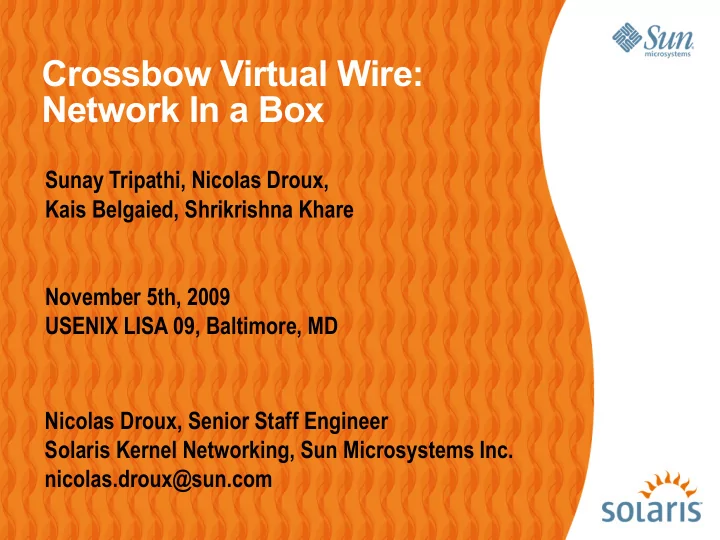

Crossbow Virtual Wire: Network In a Box Sunay Tripathi, Nicolas Droux, Kais Belgaied, Shrikrishna Khare November 5th, 2009 USENIX LISA 09, Baltimore, MD Nicolas Droux, Senior Staff Engineer Solaris Kernel Networking, Sun Microsystems Inc. nicolas.droux@sun.com
Key Issues in Network Virtualization • Fair or Policy based resource sharing in virtualized environments > Bandwidth > NIC Hardware resources including Rx/Tx descriptors > Processing CPUs • Overheads due to Virtualization > Latency, Throughput • Management > Isolation between distributed applications > Network fabric configuration • Security > New threats to L2 network • Where to solve the problem? > Switches > L3/L4 devices > Hosts www.opensolaris.org/os/project/crossbow 2
Crossbow: Solaris Networking Stack • 8 years of development work to achieve > Scalability across multi-core CPUs and multi-10gigE bandwidth > Virtualization, QoS, High-availability designed in > Exploit advanced NIC features • Key Enabler for > Server and Network Consolidation > Open Networking > Cloud computing www.opensolaris.org/os/project/crossbow 3
Crossbow “Hardware Lanes” Ground-Up Design for multi-core and multi-10GigE • Linear Scalability using ' Hardware Lanes ' with dedicated resources • Network Virtualization and QoS designed in the stack • More Efficiency due to ' Dynamic Polling and Packet Chaining ' Physical Machine Physical NIC Kernel Threads Virtual Hardware C Virtual Rings/DMA and Queues NIC Machine/Zone L A Hardware Lane Hardware Kernel Threads Virtual Virtual S Rings/DMA and Queues NIC Machine/Zone S Switch I F VLAN I Separated E Hardware Kernel Threads Squeue Application R Rings/DMA and Queues www.opensolaris.org/os/project/crossbow 4
Hardware Lanes and Dynamic Polling ● Partition the NIC Hardware (Rx/Tx rings, DMA), kernel queues/threads, and CPU to allow creation of “Hardware Lane” which can be assigned to VNICs & Flows ● Use Dynamic Polling on Rx/Tx rings to schedule rate of packet arrival and transmission on a per lane basis ● Effect of dynamic polling Mpstat (older driver) intr ithr csw icsw migr smtx srw syscl usr sys wt idl 10818 8607 4558 1547 161 1797 289 19112 17 69 0 12 Mpstat (GLDv3 based driver) intr ithr csw icsw migr smtx srw syscl usr sys wt idl 2823 1489 875 151 93 261 1 19825 15 57 0 27 ~85% ~75% Fewer ~85% Fewer ~15% More Fewer Ctx Interrupts Mutexes CPU Free Switches www.opensolaris.org/os/project/crossbow 5
Crossbow Virtual NICs (VNICs) • Pseudo MAC instances > Can be managed as if they were physical NICs > Per VNICs stats, reuse existing management tools > Link speed derived from configured bandwidth limit > High-Availability by creating VNICs on link aggregations or combining VNICs in IPMP groups • Dedicated per-VNIC hardware and kernel resources • Data path pass-through, no bump in the stack • Standards based End-to-End Network Virtualization > VLAN tags and Priority Flow Control (PFC) assigned to VNIC extend Hardware Lanes to Switch www.opensolaris.org/os/project/crossbow 6
Crossbow Virtual Switching • A virtual switch is created implicitly each time >2 VNICs are created on a data link • The MAC layer provides packet switching semantics equivalent to an ethernet switch > Data path between VNICs created on top of the same data link > Connectivity between VNICs and physical network > Per VLAN broadcast domain, isolation between VLANs • VNICs can be created on etherstub to create virtual switches independent from hardware www.opensolaris.org/os/project/crossbow 7
Crossbow Virtual Switching Example Solaris host non-global vnic0 zone ng0 global zone non-global IP Filter Virtual bge0 vnic1 vnic3 zone NAT Switch ng1 Virtual vnic2 Machine www.opensolaris.org/os/project/crossbow 8
Virtual NIC & Virtual Switch Usage # dladm create-vnic -l bge1 vnic1 # dladm create-vnic -l bge1 -m random -p maxbw=100M -p cpus=4,5,6 vnic2 # dladm create-etherstub vswitch1 # dladm show-etherstub LINK vswitch1 # dladm create-vnic -l vswitch1 -p maxbw=1000M vnic3 # dladm show-vnic LINK OVER MACTYPE MACVALUE BANDWIDTH CPUS vnic1 bge1 factory 0:1:2:3:4:5 - - vnic2 bge1 random 2:5:6:7:8:9 max=100M 4,5,6 vnic3 vswitch1 random 4:3:4:7:0:1 max=1000M - # dladm create-vnic -l ixgbe0 -v 1055 -p maxbw=500M -p cpus=1,2 vnic9 www.opensolaris.org/os/project/crossbow 9
Physical Wire w/Physical Machines Router Host 1 Host 2 Client Port 6 Port 9 Port 3 Port 1 Port 2 20.0.03 20.0.01 10.0.03 10.0.01 10.0.02 1 Gbps 1 Gbps 1 Gbps 100 Mbps 1 Gbps Switch 3 Switch 1 Virtual Wire w/Virtual Network Machines Router Host 1 Host 2 (Virtual Client Router) VNIC6 VNIC9 VNIC3 VNIC1 VNIC2 20.0.03 20.0.01 10.0.03 10.0.01 10.0.02 1 Gbps 1 Gbps 1 Gbps 100 Mbps 1 Gbps EtherStub 3 EtherStub 1 www.opensolaris.org/os/project/crossbow 10
Virtual Network Machines ● A Virtual Network Machine (VNM) is a Zone or Virtual Machine associated with a set of network functions (routing, firewall, load balancing, etc) ● A VNM has dedicated VNIC(s) with configured link speed, CPUs ● Multiple VNMs can run on a single host, connected through virtual private networks (etherstubs) or to the physical network ● Use for simulation, consolidation, testing, etc www.opensolaris.org/os/project/crossbow 11
Crossbow Flows • Crossbow flows based on the following attributes > Services (protocol + remote/local ports) > Transport (TCP, UDP, SCTP, iSCSI, etc) > IP addresses and IP subnets > DSCP labels • The following properties can be set on each flow > Bandwidth limits > Priorities > CPUs # flowadm create-flow -l bge0 protocol=tcp,local_port=443 -p maxbw=50M http-1 # flowadm set-flowprop -l bge0 -p maxbw=100M http-1 www.opensolaris.org/os/project/crossbow 12
Join Us... • Beer @ Crossbow and Solaris Networking BoF > Tonight 10:30-11:30pm (Dover A&B) > Presentation by Ben Rockwood (Joyent) > vWire demo and deep-dive discussions • OpenSolaris project and community > http://www.opensolaris.org/os/project/crossbow > crossbow-discuss@opensolaris.org > networking-discuss@opensolaris.org www.opensolaris.org/os/project/crossbow 13
Crossbow Virtual Wire: Network In a Box Nicolas Droux nicolas.droux@sun.com Solaris Kernel Networking
Recommend
More recommend